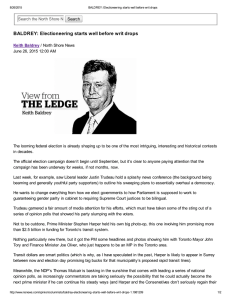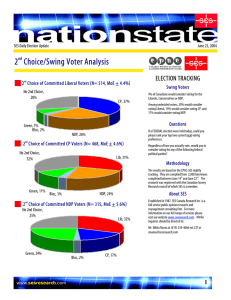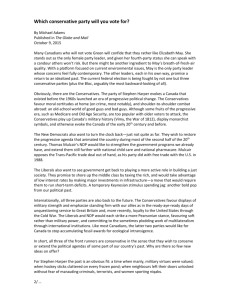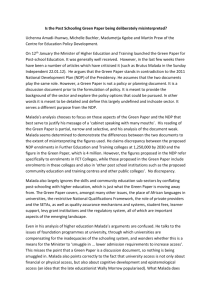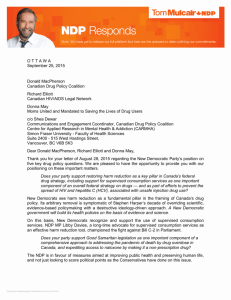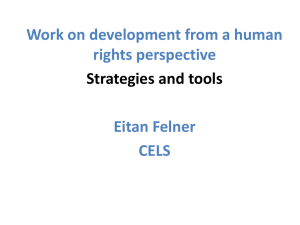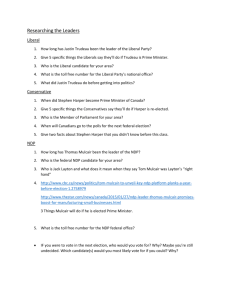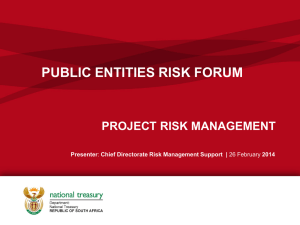Wild Card—Possibly the Most Bizarre, Unstable, Upside-Down Election since Confederation
advertisement
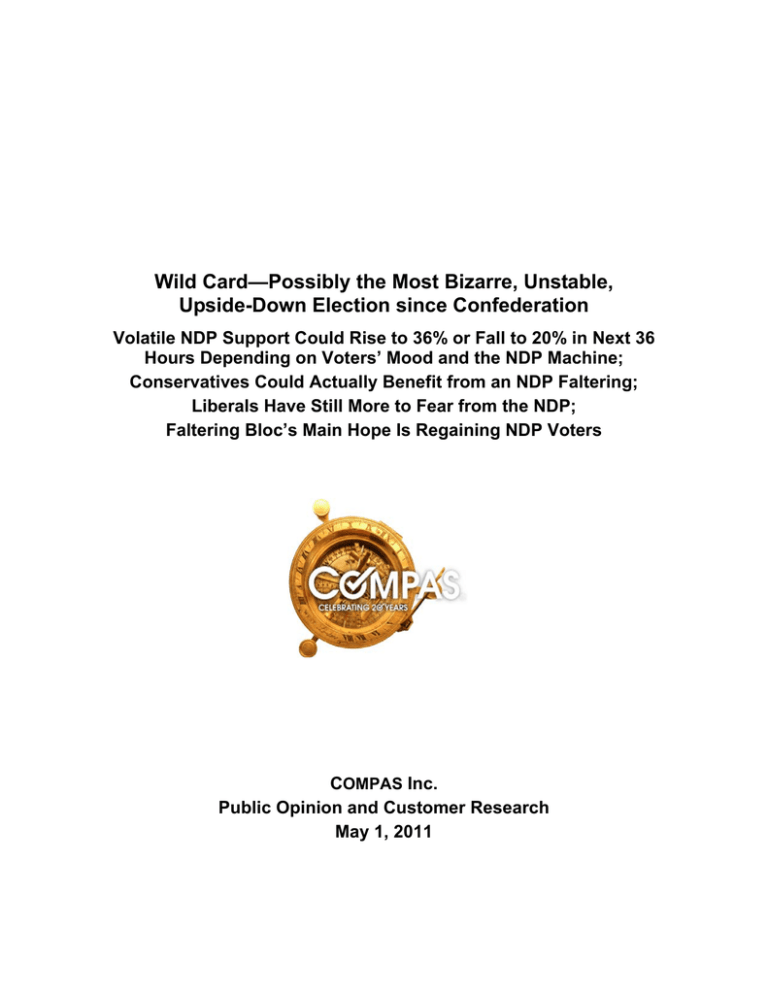
Wild Card—Possibly the Most Bizarre, Unstable, Upside-Down Election since Confederation Volatile NDP Support Could Rise to 36% or Fall to 20% in Next 36 Hours Depending on Voters’ Mood and the NDP Machine; Conservatives Could Actually Benefit from an NDP Faltering; Liberals Have Still More to Fear from the NDP; Faltering Bloc’s Main Hope Is Regaining NDP Voters COMPAS Inc. Public Opinion and Customer Research May 1, 2011 Wild Card—Possibly the Most Bizarre, Unstable, Upside-Down Election since Confederation Contents 1.0. Overview ............................................................................................... 3 1.1. Confirmatory Finding—Conservative Victory .................................. 3 1.2. New Finding # 1—the NDP Has By Far the Most to Fear and the Most to Hope for .................................................................................... 3 1.2. New Finding # 2—Conservatives Would Actually Gain from a NDP Faltering ................................................................................................. 5 1.3. Campaign 2011 as a Double-Drama Election ................................. 5 1.4. Campaign 2011 as One of the Most Bizarre, Unstable, and UpsideDown Elections since Confederation ..................................................... 6 2.0. Predicting the Vote ................................................................................ 7 2.1. If Nothing Changes—A Conservative Majority with the NDP as Official Opposition .................................................................................. 7 2.2. The Party to Watch—the NDP ........................................................ 8 2.3. Patterms of Switching ................................................................... 11 3.0. Regional Patterns ................................................................................ 13 4.0. Demographic Patterns ......................................................................... 14 4.1. The Conservatives’ and NDP Reversal in Class Support.............. 14 4.2. Evaporation of the Gender Divide ................................................. 14 5.0. Methodology ........................................................................................ 15 2 www.compas.ca Wild Card—Possibly the Most Bizarre, Unstable, Upside-Down Election since Confederation 1.0. Overview 1.1. Confirmatory Finding—Conservative Victory As detailed below, this new COMPAS poll confirms the preponderance of findings from the polls of most firms, including COMPAS’ early in the campaign, that the Conservatives are en route to victory. As in our previous poll, we anticipate a large Conservative victory, virtually large enough to assure a majority—46% vs. 26% for the NDP, as detailed below in section 2.1. 1.2. New Finding # 1—the NDP Has By Far the Most to Fear and the Most to Hope for This national COMPAS poll focuses on voter stability.1 Two dramatic findings are that as many as 61% of all voters say that they may change their mind and that the NDP vote is especially unpredictable. Far more than any other party’s support, the NDP support is capable of both a major collapse and a sizeable further increase depending upon what goes through the minds of voters during the last few hours and depending also on the strength of the NDP machine. The NDP share of the vote, currently 26%, could fall to 20% if the party fails to overcome its special challenge, that its supporters are far less familiar with their local NDP candidate than are Conservative and Liberals voters with their candidates, as detailed below, or Climb to 36% if all voters who say they could switch to the NDP in the last hours actually do. The NDP vote is by far the least stable among the major parties with 79% of NDP supporters saying that they could change their minds, as shown in table 1.2a. If any party is disappointed on election day, it could be the NDP given that the overwhelming majority of its supporters say that they could change their mind. 3 www.compas.ca Wild Card—Possibly the Most Bizarre, Unstable, Upside-Down Election since Confederation Table 1.2a: Proportion of Supporters of Each Party Saying They Could Change Their Minds in Coming Hours2 CONS 51 LIBS 65 NDP 79 GREENS 71 BLOC 45 ALL The Conservatives have the most to rejoice about because their vote is the most loyal. The high loyalty or stability of the Conservative vote is remarkable given that the Conservatives are at a high point, attracting normally Liberal voters in large numbers. Yet, even the Conservative vote is not absolutely loyal or stable, only loyal or stable compared to the others. In keeping with the proportion of NDP voters who say that they could change their minds is a high proportion of NDP voters who do not know the names of the local candidates for whom they intend to cast ballots. Conservative and Liberal voters are about 50% more likely to know the names of the candidates they plan to vote for than are NDP voters, as shown in table 1.2b. Admittedly, voters do not need to know before Monday the names of the local candidates for whom they intend to cast ballots, but knowledge of these names is a potential indicator of stability of commitment. Table 1.2b: Proportion of Supporters of Each Party Who Know the Name of the Local Candidate They Say They Will Vote for3 CONS 59 LIBS 64 NDP 39 GREENS 35 BLOC 48 While the NDP has most to fear in terms of the possibility of its support collapsing, it also has the most to hope for. Respondents were asked for the names of the parties they might switch to if they changed their minds. The NDP is the biggest winner, as shown in table 1.2c. 4 www.compas.ca Wild Card—Possibly the Most Bizarre, Unstable, Upside-Down Election since Confederation Table 1.2c: Proportion of All Potentially Switchable Votes That Could Be Directed to a Given Party4 CONS 11 LIBS 29 NDP 34 GREENS 20 BLOC 6 1.2. New Finding # 2—Conservatives Would Actually Gain from a NDP Faltering While political scientists and journalists often talk about parties being on a left-right spectrum, voters are not behaving that way in a uniform or predictable way, as shown in table 2. An NDP retreat would see its supporters going in all directions, including towards the Conservatives. Though more NDPers would switch to the Liberals than Conservatives, the Conservatives are so far ahead of the Liberals that the Conservatives could well benefit more in seats from an NDP faltering, given our electoral system. In practice, the Conservatives have already won over almost all the Liberals they could. As a result, 70% of potential switchers to the Conservatives are actually NDP voters. Among NDP voters who contemplate the possibility of switching, 22% would switch to the Conservatives, 38% to the Liberals with the rest split among the Greens (25%) and the Bloc (15%), as shown in table 2. In keeping with the absence of a strong left-right divide, at least as many Conservatives would switch to the NDP as the Liberals if indeed they switched, as shown in table 2. 1.3. Campaign 2011 as a Double-Drama Election In election campaigns, there are many types: No-drama elections—the campaigns end up where they started with nothing consequential happening in between; Half-drama elections—the outcome changes over the course of the campaign but polls predict accurately the final outcome; 5 www.compas.ca Wild Card—Possibly the Most Bizarre, Unstable, Upside-Down Election since Confederation Full-drama elections—either major changes take place during the campaign itself or dramatic, unpredicted changes take place in the last 48 hours. The 2004 federal election was a classic example of the latter, a kind of 11th hour repentance with one-fourth of the electorate changing its mind in the last 24 hours, largely going back to the Liberals (http://www.compas.ca/040628GlobalTVEDayPollPart1-E.html). The 2011 campaign threatens to be a double-drama election: huge midcampaign changes involving the decline of the Bloc and the surpassing of the Liberals by the NDP, followed by a high chance of major last minute changes. 1.4. Campaign 2011 as One of the Most Bizarre, Unstable, and Upside-Down Elections since Confederation The 2011 federal election will likely go down in Canadian history as one of the most bizarre, unstable, and upside-down elections since Confederation: Bizarre—because Canada’s historic, natural governing party, the Liberal party of Laurier, Mackenzie King, St. Laurent, Pearson, Trudeau, and Chretien, faces the prospect not just of being shut out of power again but of being relegated to third, “also-ran” position in a campaign without cleavage issues; Unstable—because, on the eve of voting, the volatile NDP vote could surge to 36% because many non-NDP voters tell COMPAS that they are thinking of switching to the NDP in the next few hours, or NDP support could fall back to as low as 20% given the number of NDP voters who are unfamiliar with the local candidate of their party. Non-NDP voters are about 50% more likely than NDP 6 www.compas.ca Wild Card—Possibly the Most Bizarre, Unstable, Upside-Down Election since Confederation voters to know the name of the local candidate for whom they plan to vote; and Upside-down because the historic middle class or bourgeois bastion of the Liberal-Conservative establishment, university-educated voters, have become the fortress of the anti-establishment NDP, while less educated and hence lower status Canadians are set to become the stronghold—the impregnable fortress—of the Conservatives. The election is also upside-down because the NDP will do far less well in its birthplace, the west, or in the NDP-supporting union heartland of Ontario than it will do in Quebec and Atlantic Canada, from which the party was shut out for generations. 2.0. Predicting the Vote 2.1. If Nothing Changes—A Conservative Majority with the NDP as Official Opposition If voters do not change their minds and NDP voters turn out to vote in the same proportion as everyone else, the Harper Conservatives will likely be sufficiently far ahead of the Liberals and NDP to form a majority (see table 2.1).. 7 www.compas.ca Wild Card—Possibly the Most Bizarre, Unstable, Upside-Down Election since Confederation Table 2.1: Distribution of the Vote if Voters Do Not Change Their Minds and If NDP Voters Turn Out to Vote in the Same Proportion as Other Voters5 2.2. The Party to Watch—the NDP The party to watch is the NDP. This is because, of all the parties, the NDP is the party with greatest prospects of both further growth and significant decline. Respondents were asked three non-conventional questions to measure volatility, to: 8 www.compas.ca Wild Card—Possibly the Most Bizarre, Unstable, Upside-Down Election since Confederation score their commitment to voting,6 important because turnout is in longterm decline and will almost certainly be under two-thirds of the electorate; name the local candidate for whom they intended to vote,7 another indirect measure of likelihood of voting; and indicate to which party they might switch at the last moment if new events justified such a switch,8 a measure of volatility. If the preferences of only the most assertively committed voters were calculated, the polling results would hardly change, as shown in fig. 2.2a. If one counted only the preferences of voters who can name the local candidate of their preferred party, the Conservatives and Liberals would benefit while the NDP and Greens would experience declining numbers, as shown in fig. 2.2b. The NDP would decline to just behind the Liberals. This is because only 39% of NDP voters can identify by name their local candidate compared to 59% of Conservatives and 64% of Liberals. Given that NDP voters are less apt to know the name of their local candidate than are the others, a reasonable inference is that NDP voters will have a lower turnout than expected on election day. Without a further swing to the NDP in the hours ahead, the NDP is likely to underperform its polling numbers because its voters are less likely to actually cast a ballot. Yet, a further swing in favour of the NDP cannot be ruled out, as discussed in section 2.3, below. In the 2004 election, approximately a fourth of the electorate changed its voting intentions in the 24 hours before balloting, according to the COMPAS poll conduct on election day before balloting came to an end. Much of that swing was from Conservatives to Liberals. 9 www.compas.ca Wild Card—Possibly the Most Bizarre, Unstable, Upside-Down Election since Confederation Table 2.2a: Distribution of the Vote if Ballots Were Cast Only by the 82% of Voters Who Score 7 on a 7 Point Scale of Commitment to Vote9 10 www.compas.ca Wild Card—Possibly the Most Bizarre, Unstable, Upside-Down Election since Confederation Table 2.2b: Distribution of the Vote if Ballots Were Cast Only by the 53% of Voters Who Correctly Named the Local Candidate of the Party They Intended to Vote For10 2.3. Switching In this election, the NDP would benefit the most from switching but potential switching is far more multi-directional than it was in 2004. Table 2 shows that voters are willing to consider switching from every party to almost every other party, albeit in varying numbers. The key conclusions from the data on potential switching are that: the NDP has the most to fear given the large share of its voters willing to consider switching, as shown in table 1.1a, as well as the most to hope for given that the NDP 11 www.compas.ca Wild Card—Possibly the Most Bizarre, Unstable, Upside-Down Election since Confederation is the first choice among potential switchers, as shown in table 1.2c; the Conservatives have the least to fear because their numbers are high and more solid and less switchable than the numbers of the other major parties; The Liberals have reason to fear because they are in third place and because any bleeding would go to the NDP, cementing the Liberals’ third place position; The Bloc are doing poorly but have some reason to hope that they could retake some support from the NDP. Table 2: Patterns of Potential Switching (Vertical Percent) POTENTIAL SWITCH TO… Cons Libs NDP Greens Bloc CURRENT CONS CURRENT LIB CURRENT NDP CURRENT GREEN CURRENT BLOC NA 35 40 23 1 18 NA 68 11 3 22 38 NA 25 15 0 27 73 NA 0 0 20 60 20 NA 12 www.compas.ca Wild Card—Possibly the Most Bizarre, Unstable, Upside-Down Election since Confederation 3.0. Regional Patterns The historic party of the west, the NDP stands to become the main party, or at least a very strong party, in Canada east of Ontario. 80% 71% 70% 60% 50% 15% 25% 48% 11% 48% 14% 40% 30% 44% 45% 38% 32% 29% 22% 20% 20% 15% 8% 10% 5% 0% 0% BC 4% 5% 0% Prairies Conservatives 1% 0% ON Liberals NDP Green Party QC Atlantic The Bloc Québécoise 13 www.compas.ca 0% 0% Wild Card—Possibly the Most Bizarre, Unstable, Upside-Down Election since Confederation 4.0. Demographic Patterns 4.1. The Conservatives’ and NDP Reversal in Class Support The age-old idea of the left-right spectrum is that left are on the side of people with lower income or lower socio-economic status and the right on the side of privilege. This election sees a complete reversal when the vote is examined by education, a proxy for socio-economic position. The NDP almost equals the Conservatives among university graduates, trailing badly the Conservatives among voters with apprenticeship training, trades certificates, and high school education or less. Table 4: Education as a Proxy for Socio-Economic Status and the Vote (Horizontal Percent) POTENTIAL SWITCH TO… Apprenticeship, trade certificate, high school, or less Community College University degree CONS LIB NDP GREEN BLOC 51 15 24 1 10 51 14 21 4 7 35 22 32 7 4 4.2. Evaporation of the Gender Divide There exists essentially no gender difference in the vote except in the case of the Greens, for which males express greater support. 14 www.compas.ca Wild Card—Possibly the Most Bizarre, Unstable, Upside-Down Election since Confederation 5.0. Methodology A national representative sample of n=750 voters was interviewed by professional interviewers using CATI on Thursday and Friday, April 28-29, 2011. By convention, samples of this size are deemed accurate to within approximately 3.6 percentage points 19 times out of 20. The principal investigator was Dr. Conrad Winn, reachable at 416 598-0310 x40 or cwinn@compas.ca. 1 N=750, deemed accurate to within approximately 3.6 percentage points 19 times out of 20. Fielded Thursday and Friday. 2 “One final question. Suppose something happened in the next couple of days to change you mind about how you were voting. Which party could you change to?” OPTIONAL PROMPT 3 ”Could you please tell me the name of the candidate you plan to be voting for in your local riding or constituency.” 4 This is based on answers to the following question: “One final question. Suppose something happened in the next couple of days to change you mind about how you were voting. Which party could you change to?” OPTIONAL PROMPT 5 Vote intention reflected a combination of responses to the following questions: At the present time, do you plan to vote for RANDOMIZE a. the Conservatives led by Stephen Harper, b. the Liberals led by Michael Ignatieff, c. the N.D.P. led by Jack Layton, d. the Green Party Led by Elizabeth May, e.QUEBEC ONLY: The Bloc Québécoise led by Gilles Duceppe, f. UNPROMPTED: dnk, refuse plus 4. IF DNK/REFUSE Then which party are you leaning to? OPTIONAL PROMPT RANDOMIZE a. the Conservatives led by Stephen Harper, b. the Liberals led by Michael Ignatieff, c. the N.D.P. led by Jack Layton, d the Green Party Led by Elizabeth May, e.QUEBEC ONLY: The Bloc Québécoise led by Gilles Duceppe, f. UNPROMPTED: dnk, refuse. 6 ”A lot of people aren’t sure they will vote on Monday because of the Royal Wedding, the busy spring season, sports, or the way the election campaign has unfolded. On a 7 point scale where 1 means you definitely will not vote on Monday and 7, you know with absolutely certainly that you will be voting, what score would you give yourself?” 7 ”Could you please tell me the name of the candidate you plan to be voting for in your local riding or constituency.” 8 “One final question. Suppose something happened in the next couple of days to change you mind about how you were voting. Which party could you change to?” OPTIONAL PROMPT 9 See preceding note. 10 See preceding note. 15 www.compas.ca
